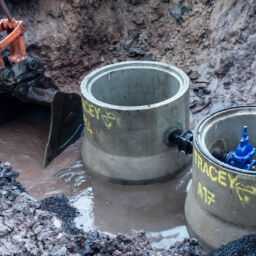We go around the Bo Bo Aung Shrine and at the back of it we stay in front of the Temple of Dhammazedi and Dhammapala built by the Mon king Dhammazedi. Usually, temples, pagodas, shrines, etc. are guarded by a pair of chinthes, devas, nagas, ogres, and so on but this is different at this temple in so far as it is guarded by one chinthe (left) and one tiger (right). The temple houses two Buddha statues and people say that the temple is placed where the beam of light concentrated by the diamond orb (sein bu) of the Shwedagon Pagoda hits the terrace. This may be true but neither have I ever seen the ray myself nor have I ever met anyone in person who did. Some sources say that the Temple of Dhammazedi and Dhammapala is one of the nine Shwedagon Pagoda wonders and that the Sandawdwin Pagoda is not one of them; others say vice versa.
We continue southwards and have now reached the Eastern Stairway. Here at the top of the stairway king Dhammazedi placed in 1485 the Dhammazedi stones we have seen in the north-eastern corner where they were moved to in 2008. This stairway, more precisely the entrance at street level, was also the place were on 15 March 1929 a celebration took place on the occasion of the return of the control of the Shwedagon Pagoda to the Burmese by the British.
Opposite the eastern stairway is the Kakusandha Buddha Adoration Hall. Inside the hall are several Buddha statues but the main Buddha is, of course, the one this hall is dedicated to: the 25th Buddha, Kakusandha Buddha, in an illuminated cave at the back of the hall. This statue has like the other main Buddha’s a neon halo and is made of stone after the original statue was severely damaged by the great fire in 1931. What is striking here is the fact that not only the palm of Kakusandha Buddha’s hand is turned upwards instead of being as usual turned downwards but also those of three of the four in front of his cave sitting Buddha statues. This is in so far striking as this mudra is not in conformity with any of the many mudras prescribed in the old scripts.
The Kakusandha Buddha is one of the nine wonders of the Shwedagon Pagoda.
The Kakusandha Buddha Adoration Hall that fell victim to the great fire on the Shwedagon Pagoda in 1931 was originally built in 1841 by king Tharrawaddy Min’s chief queen, Ma May Gale and the first time renovated in 1869. After being, following the great fire, re-built based on the original plans it was re-opened in 1940.
On the right hand side of the Kakusandha adoration hall you can see the Golden Shan Umbrellas.
To the left and right of the hall is a Planetary Post for the Moon. One of you said that he is Tiger; was it you? OK, then you are born on a Monday and this is your place to perform your devotional ‘yadayar’. We are waiting and when you are back I will tell you something about the Tawa Gu Buddha.
Now we take a look at the Tawa Gu Buddha who is placed on the upper terrace of the Shwedagon stupa in a niche above and behind the Kakusandha Buddha adoration hall. The terrace is some 18 feet/6 metres wide and accessible by stairs located beside the Konagamana Buddha Adoration Hall at the southern stairway.
As you may remember this terrace cannot be visited by women and requires for men the permission of the Shwedagon Pagoda Security. However, we can see the statue from here on the monitor at the column over there in the Kakusandha Buddha devotion hall. The Tawa Gu Buddha who is said to have a Ruby inside his head and would be capable of working miracles. The statue is relatively small and is different from all the other Buddha statues on the Shwedagon in so far as his eyes give a different expression to the face. I have heart people describing the eyes as ‘real’ or ‘lively’. Owing to the Rubies on the brow and in his eyes enshrined there by Bo Bo Aung (well, people believe that) and his ‘lively’ eyes the Tawa Gu Buddha is also called ‘Lively Ruby Eyes Buddha’ in Burmese ‘Padamya Myet Shin Buddha’. The Tawa Gu Buddha is one of the nine wonders of the Shwedagon Pagoda.
Having admired the Tawa Gu Buddha we see diagonally across on the right hand side of the eastern stairway the U Nyo Pavilion, which was completed in 1938. What makes this pavilion worth mentioning is that you can here see a selection of beautifully carved wooden jatakas depicting scenes of Gautama Buddhas life including the scene of Siddhartha’s birth celebration in the course of which the hermit Asita foresaw that Siddhartha would one day become either a great king or great holy man.
Oh, you are lucky. Look over there. You see the people with the Htishwes (golden umbrellas) over there? Yes, you are right. That is a Shin Pyu Procession.
Continuing southwards we are now at the Hamsa Prayer Pillar. The Hamsa prayer pillar has its name from the golden bird on the top of it. The Hamsa Bird, also called Hintha Bird, is the sacred bird of the Hamsawaddy (Hansawaddy) Mon Dynasty. For this reason the Hamsa (Hintha) Bird, representing perfect union, perfect balance and perfect life, was on the flags of the Mon kingdoms and is still on the flags of the Pegu (Bago) Division and the Mon State. Devotees praying at this post believe that they will become as healthy, successful and rich as the kings and queens of this dynasty.
Just right from the Hamsa prayer pillar in direction of the main stupa we have here the Planetary Post for the Mars located in the south-east of the Shwedagon Pagoda terrace. As you may remember the Mars corresponds to Tuesday born and is associated to the lion. Someone of you born on a Tuesday? You? Well, then here is the place to make your ‘yadayar’, in other words, to promote your luck. When you are ready we will continue.
Now we turn right and over there you already see the pavilion of the southern stairway where we have started our walk around the central stupa our circumambulation, respectively. But before we go into the south-eastern corner to rest a few minutes under the Bodhi tree that was planted there and then return to the eastern stairway to leave the Shwedagon Pagoda in order to continue our ‘Yangon Pagoda Sight Seeing Tour’ we go to the building located to the left of the upper landing of the southern stairway.
Here we are. This is the Hall of Carousel. Let us step closer and you will see why this building is called Hall of the Carousel. Yes, because there is a slow turning carousel with four silver bowls on it. Do you see what these locals are doing? Right, they try to toss coins into the bowls. I have here some coins for you and you should join them and do as they do. Why? Well, because when you succeed in placing your coin in one of the bowls you will have good fortune. I think it’s worth a try.
Ha, you see, some of you made it. Be happy, that is a good sign. By the way, here on the walls you can see very beautiful wood carvings. Starting from the left side they are telling the story of Bhuridatta, the Naga Prince, known as Bhuridatta jataka.
Stepping out of the hall of carousal we have the central stupa in front of us and turn right into eastern direction.
Having arrived at the south-eastern corner of the main platform we can see diagonally across in the far south-eastern corner the bodhi tree. That is where we now go to rest a bit in the shadow of the Bodhi Tree.
OK, let us sit down enjoy the view and have some cookies and water. This one is like the Bo trees in the north-western corner grown from a cutting of the very Bodhi Tree in northern India under which as Buddhists believe Siddhartha Gautama attained enlightenment (bodhi).
Having gathered some strengths we return to the eastern stairway and leave the Shwedagon Pagoda. We are now about two third down from the pagoda platform and have to cross the Ar Za Ni Street that divides the stairway in a lower part and an upper part.
From here you can take taxis when you want to leave the pagoda from here or arrive here by taxi if you so wish. In southern direction the Ar Za Ni Street leads in the former Lake Road, now U Htaung Bo Road where the southern stairway that we have used to climb up to the Shwedagon Pagoda is located. In northern direction it is, passing the northern entrance, leading in the West Shwegondaing Road.
We have reached the foot of the stairway and here in front of the fence at the end of the stone slaps the floor is paved with we can put on our slippers.
Now we have left the Shwedagon Pagoda compound and as you can see here too are two chinthes guarding the stairway. However, these ones are a lot smaller than the chinthes guarding the entrance to the southern stairway.
This is now the Kyar Taw Ya Street. Here are some small food and souvenir stalls and a few steps further down the street is the corner of Kyar Taw Ya Street and Yae Ta Shae Street. So, here on our left is the Bahan Market (Zay) Hall. All along Yae Ta Shae Street running left are shops selling food, flowers, paper umbrellas, hand fans, monk robes, monk slippers, monk umbrellas, oh well, just everything devotees may want to have prior to their visiting the Shwedagon Pagoda and/or one of the monasteries.
This is the end of our visit to the Shwedagon Pagoda. I hope you have enjoyed it and that we will meet again.
AUTOPOST by BEDEWY VISIT GAHZLY



